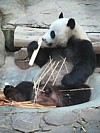|
panda
Large, bear-like, black and white mammals native to
China and Tibet.
Their natural habitat is high-up in the mountains
of the
Himalayas and they feed
exclusively on
bamboo.
Thailand possesses two pandas, that were donated by
China as friendship
ambassadors, and which are kept in the specially built Panda House (map) at Chiang Mai Zoo (map - fig.). The
Chiang Mai
pandas are named Chuang-Chuang and Lin-Hui, and in May 2009 Lin-Hui
at the age of seven, surprised Thai zoo officials when she on 27 May gave
birth to a healthy female panda cub, putting Thailand on the map as
one of the few countries in the world that has bred a panda in
captivity outside of China.
The cub was
named Lin Bing (林冰) or Lin Ping, which is Chinese for ‘Ice Forest’
and consist of a sound loan for the name of the mother panda on the
one hand, and the city's
Ping River on
the other. After the birth of the baby panda, stuffed pandas and
panda accessories
(fig.)
became a very
popular and sought after item throughout the kingdom, so much so that it
was in fact reported in the press, that two guys on a motorbike raided a fuel station, demanding
at gunpoint only a cuddly toy panda from the store− their only take! Another consequence of
the birth of the panda cub was the launch of Panda Channel,
i.e. Lin Ping reality TV
(fig.),
which broadcasts the young panda live around the clock, 24-7. Of
course, due to their cute looks, pandas have long been popular
around the world. In China, their native country (fig.), one or
more pandas are depicted on the
popular
silver (fig.) and gold Panda Coins
(fig.) issued annually
(fig.) by
the People's Bank of China (fig.)
since 1982 up to present (fig.). Also called Giant Panda, in Thai known as mih
paendah, and in Chinese referred to as xióng māo (熊猫), which literally
means ‘bear-cat’. See also POSTAGE STAMPS, TRAVEL PICTURE, SLIDESHOW PHOTO, and WATCH VIDEO.
回






|

